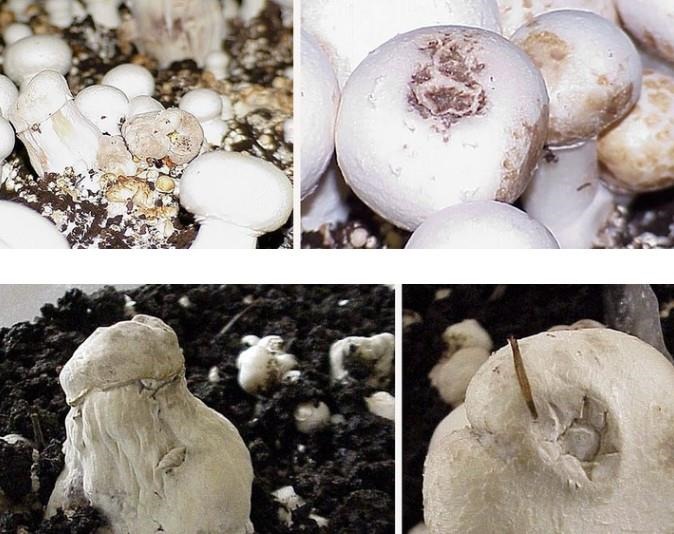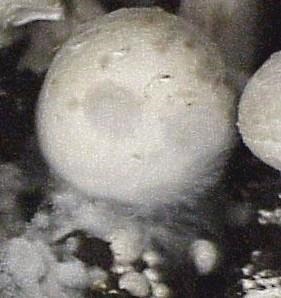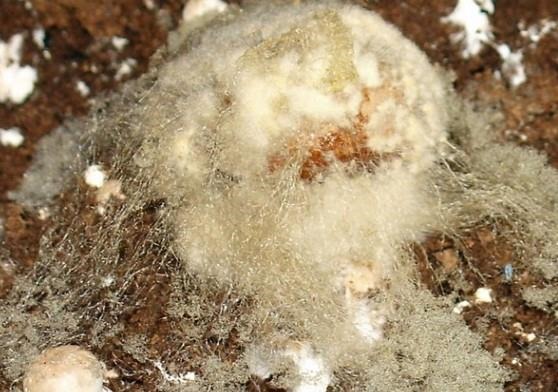By Maria Gorgo - Gourovitch and David Meigs Beyer
There are many fungal pathogens of mushrooms, but only a few of them currently affect commercial mushroom farms. Some of these are true pathogens attacking the mushroom mycelium, while others can simply outcompete mushroom mycelium growth. Fungal pathogens can affect the quality of the product, reduce production, or both. But all of the pathogens reduce the total crop return, often significantly.
Many control methods, such as sanitation, are useful for all of the diseases. There are also control measures specific to each disease.
Infection takes on a variety of forms and has various symptoms, from small spotting on the surface of a mushroom cap to complete infection of the fruiting body so that it is unrecognizable as a mushroom. Appearance will depend on the timing of infection and the number of spores. Below are the most important fungal diseases of mushrooms.
Dry Bubble (Lecanicillium fungicola; previously named Verticillium)
Symptoms: Bubble and spot (Figure 1)
Control:
- Do not touch!
- Avoid vectors: water, equipment (waterers and watering equipment and picking baskets, ladders, and tools), people (dirty hands and clothes), flies, dust and water particles, brooms, and high-pressure sprays.
- Learn to identify bubble and all symptoms.
- Cover infected mushrooms with salt or spray alcohol.
- Steam early when infestations are heavy to reduce spore load on the farm.

Figure 1. Symptoms of dry bubble. Photo credit: David M. Beyer
Green Mold (Trichoderma aggressivum)
Signs and symptoms:
- Dark green mold patches on casing that spread to lesions on stem
- Starts out gray and later turns white along the edges and green as it sporulates (Figure 2)
- Dark green spores
Control:
- Use nongrain spawn.
- Avoid vectors: people, equipment, plastic.
- Identify and control flies and mites.

Figure 2. Green Mold Photo credit: David M.Beyer
Cobweb (Cladobotryum or Dactylium)
Symptoms:
- Weft-cotton-like mycelium (usually white; sometimes gray, pink, or yellow) covering casing, mushrooms, and/or pins (Figure 3)
- Flesh-colored spots
Control:
- Avoid mushroom wet cap or high relative humidity (95–100 percent); germination occurs in hours at temperatures of 60–65°F.
- Turn off air handlers when watering an infected room! Spores are readily distributed in air currents and by watering; very little air movement is required to dislodge spores that can then be carried considerable distances.
- Spot covering or removing infected mushroom may favor disease development.
- Cover infected mushrooms with a damp paper towel before applying salt, alcohol, or gypsum paste.

Figure 3. Cobweb mycelium. Photo credit: David M. Beyer
Bush, Bread, or Barber Mold (Syzygites megalocarpus)
Symptoms:
- Bushy, hairlike mold and light flesh-colored spots (Figure 4)
- Usually white, turning gray or yellow
- Can cover casing, mushrooms, and pins
Control:
- Remove dead mushroom tissue from the beds, walkways, and floors.
- Spot cover with wet paper towel and salt (as with cobweb).

Figure 4. Syzygites. Photo credit: David M. Beyer
Source : psu.edu